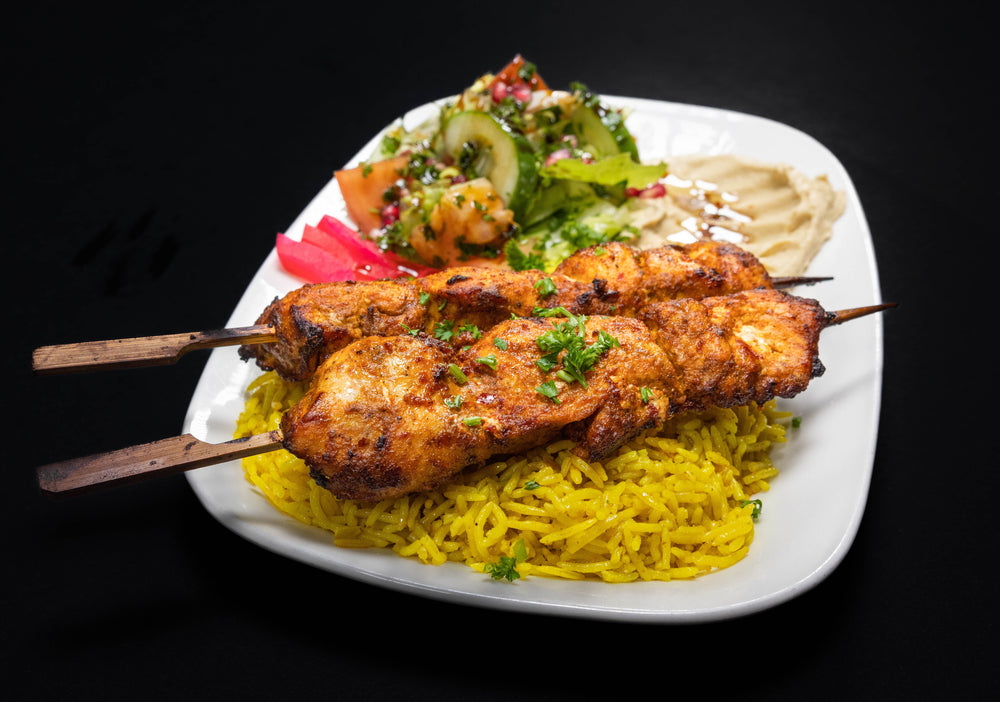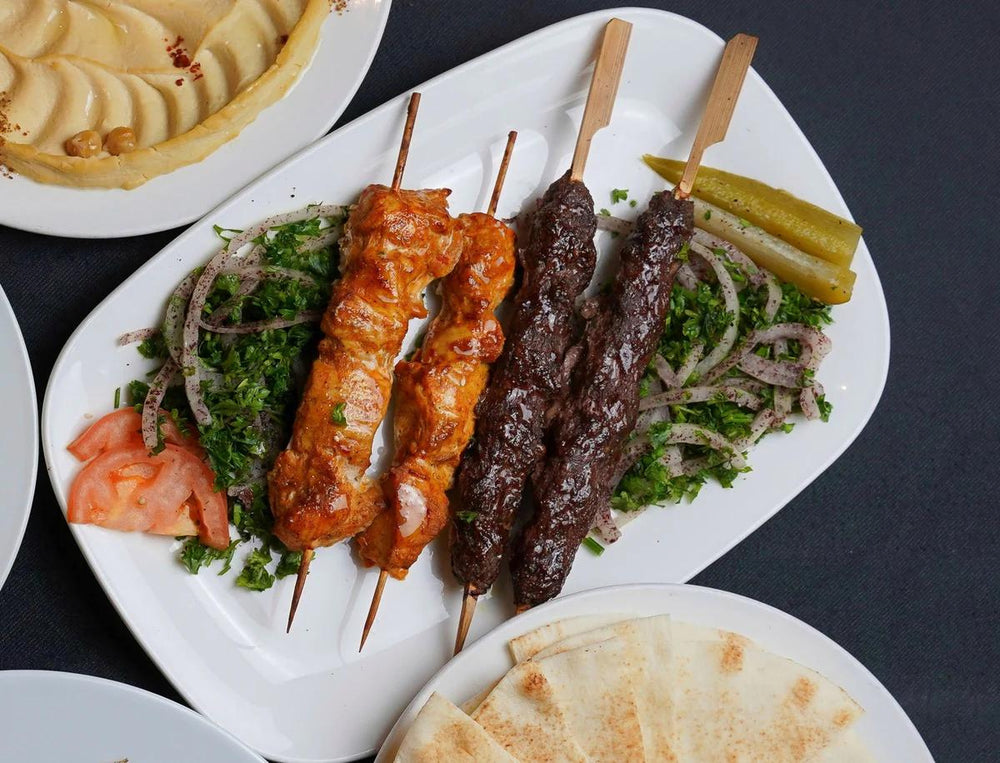A Deep Dive Into Syrian Cuisine: Comprehending Its Cultural Relevance and Halal Elements
Syrian cuisine personifies an abundant tapestry of cultural impacts and historic stories. Each meal informs a story of community and custom, highlighting the importance of common meals. The adherence to halal techniques not just mirrors religions however likewise shapes the identity of Syrian cooking. As worldwide events challenge these cooking customs, the durability of this cuisine remains a centerpiece of social preservation. What exists behind the tastes that define this withstanding heritage?
The Historical Origins of Syrian Cuisine
Syrian food has advanced over centuries, its historic origins are deeply linked with the region's varied cultural impacts. Situated at the crossroads of different people, Syria has absorbed cooking techniques from the Phoenicians, Greeks, Romans, and Ottomans, amongst others. This rich tapestry of background has added to a cuisine identified by a mix of flavors, seasonings, and cooking strategies. The productive lands of the area have likewise played an essential function, offering a wealth of grains, fruits, and vegetables that form the structure of numerous recipes. The introduction of new active ingredients via trade and occupation even more enriched the cooking landscape, allowing for the advancement of unique local specialties. Furthermore, the impact of neighboring countries has actually caused a vibrant exchange of culinary concepts, solidifying Syria's setting as a considerable player in the wider context of Center Eastern gastronomy.

Typical Syrian Dishes and Their Cultural Importance
Typical Syrian meals are not only cooking staples yet also carry deep cultural significance, reflecting the country's rich heritage. Famous dishes, often prepared throughout cheery occasions, work as a means of unifying households and areas. These dishes symbolize the tastes of Syria while strengthening social bonds with shared customs and events.
Iconic Syrian Staples
When exploring the rich tapestry of Syrian food, one uncovers a variety of famous dishes that not only tantalize the taste buds yet likewise symbolize the nation's social heritage. Among these staples, Kabsa attracts attention as a fragrant rice recipe, typically skilled with spices like saffron and cardamom, representing friendliness. Fattoush, a vivid salad made with combined greens and crispy bread, shows the relevance of fresh ingredients in Syrian cooking. Muhammara, a spicy dip made from peppers and walnuts, showcases the abundant tastes particular of the area. Additionally, Kibbeh, a dish made from bulgur and minced meat, is typically considered a national prize, standing for public celebrations. Each recipe informs a tale, attaching people to their origins and practices.
Joyful Meal Customs
Syrian cheery dish traditions are abundant with meaning and importance, as families collect to commemorate vital occasions through the sharing of cherished recipes. Meals often showcase a selection of typical foods, with recipes like tabbouleh, kibbeh, and mansaf taking center phase. Each recipe brings cultural history; for instance, kibbeh, made from bulgur and minced meat, stands for hospitality and abundance. Throughout Ramadan and Eid, households prepare unique sugary foods such as maamoul, symbolizing happiness and unity. These gatherings cultivate area bonds, as sharing a dish indicates love and togetherness. The prep work and pleasure of these recipes mirror Syria's varied culinary heritage, linking household customs and local impacts, thereby improving the festive experience and protecting social identity.
The Duty of Household and Neighborhood in Syrian Food Society
Food acts as a necessary thread that weaves with each other family members and community in Syrian society. Meals are typically communal experiences, where households gather around a table to share standard dishes that mirror their heritage. The prep work of food is a public activity, with generations functioning side by side, passing down dishes and cooking methods. This practice reinforces domestic bonds and fosters a feeling of belonging within the community.Special occasions and religious parties additionally highlight the relevance of food in Syrian society. Throughout these events, family members prepare elaborate dishes that offer not only to nurture but additionally to express love and hospitality. The act of sharing food signifies unity and support among close friends and neighbors, enhancing social ties. Through these shared culinary experiences, Syrians cultivate a solid identity rooted in their rich social background, showing how food transcends plain nourishment to come to be a vital component of their social textile.
Halal Practices in Syrian Cooking
In the context of common dishes and family members gatherings, halal methods play a substantial role in Syrian cooking. These methods originate from Islamic nutritional regulations, guaranteeing that food is ready and consumed in a way that lines up with faiths. For several Syrian family members, adherence to halal concepts influences different facets of dish prep work, from sourcing ingredients to cooking methods.Animals used for meat should be slaughtered according to particular guidelines, highlighting humane treatment and invoking the name of Allah. In addition, cross-contamination with non-halal products is very carefully stayed clear of in both home cooking areas and business establishments.This dedication to halal not only reflects spiritual commitment however also cultivates a sense of community, as family members often collaborated to share meals that recognize these customs - Brunch Kitsilano Vancouver BC. Subsequently, halal methods are deeply woven into the fabric of Syrian cooking society, shaping both day-to-day life and cheery celebrations
Active Ingredients That Define Syrian Flavors

The significance of Syrian food is formed by an unified blend of key spices and herbs that enhance its distinctive flavors. Traditional cooking techniques further elevate these components, showcasing the abundant culinary heritage of the region. A review of important ingredients discloses the fundamental duty additional info they play in developing genuine Syrian meals.
Trick Flavors and Natural Herbs
A vivid tapestry of tastes characterizes Syrian cuisine, with crucial spices and natural herbs playing an important role in specifying its significance. Famous among these are cumin, coriander, and sumac, which offer deepness and warmth to various meals. Cumin, with its nutty scent, usually enhances stews and smoked meats, while coriander adds a citrusy note to salads and dips. Sumac, recognized for its tasty flavor, lightens up dishes and is often sprinkled over fattoush or kebabs. In addition, cinnamon and allspice supply a subtle sweet taste, typically found in both wonderful and savory prep work. Fresh herbs like parsley, dill, and mint are additionally important, using a burst of freshness and balancing the abundant, intricate flavors that make Syrian cuisine one-of-a-kind.
Typical Cooking Strategies
Cooking strategies in Syrian cuisine mirror a deep-rooted practice that improves the tastes of its active ingredients. Techniques such as slow-cooking and braising are generally employed, permitting flavors and herbs to blend magnificently with meats and veggies. Grilling, especially over charcoal, imparts a great smoky richness to meals like kebabs, while steaming is frequently made use of for rice, maintaining its texture and preference. In addition, sautéing is favored for preparing fragrant bases, often beginning with onions and garlic to develop deepness. Fermentation contributes in creating distinct tastes, evident in meals like pickled vegetables. These methods not only highlight the high quality of components yet additionally personify the communal spirit of food preparation, bringing family members with each other around shared meals steeped in practice.
Important Active Ingredients Introduction
While exploring Syrian cuisine, one swiftly uncovers that important components play an essential role in specifying its one-of-a-kind flavors. Olive oil, a staple, offers splendor and deepness, usually working as a base for numerous dishes. Fresh natural herbs, such as cilantro, mint, and parsley, add lively scents and tastes, boosting the overall experience (Brunch Kitsilano Vancouver BC). Flavors like cumin, coriander, and cinnamon are frequently used, including heat and intricacy to dishes. Additionally, Syrian cuisine greatly includes grains, specifically bulgur and rice, which offer as essential parts in different dishes. Pulses, specifically lentils and chickpeas, supply both nourishment and texture. Together, these active ingredients develop the harmonious equilibrium that identifies Syrian meals, reflecting the nation's abundant culinary heritage and social importance
The Effect of Battle on Syrian Culinary Practices
Although the battle in Syria has functioned devastation throughout the country, its influence on culinary practices exposes a complex interaction of durability and adjustment. As areas encountered displacement, traditional dishes were modified due to the shortage of active ingredients look at these guys and resources. Households frequently count on in your area readily available fruit and vegetables, incorporating brand-new tastes and methods right into their dishes, which resulted in the development of one-of-a-kind interpretations of classic dishes.Moreover, the war fostered a spirit of uniformity amongst displaced chefs and home cooks, that shared their cooking knowledge with social media sites and community kitchen areas. This sharing of dishes not just preserved cultural heritage however likewise developed a sense of belonging among those affected by the problem. Regardless of the challenges, the interest for food continues to be a unifying force, allowing individuals to preserve their identification and get in touch with their origins, also in exile. As a result, Syrian food proceeds to evolve amid misfortune, showing both an abundant background and contemporary resilience.
Often Asked Questions
What Are Typical Food Preparation Methods Used in Syrian Food?
Common cooking strategies in Syrian cuisine consist of barbecuing, cooking, sautéing, and cooking. These methods improve textures and flavors, enabling the creation of varied recipes that show the region's abundant cooking heritage and customs.
Just How Has Globalization Influenced Syrian Food?

Are There Vegetarian Options in Typical Syrian Recipes?
Vegan choices are prevalent in standard Syrian dishes, including active ingredients like chickpeas, lentils, and veggies. Popular recipes such as Mujadara and Falafel emphasize this diversity, accommodating various nutritional preferences while maintaining the abundant flavors of the cuisine.
What Beverages Set Well With Syrian Dishes?
Beverages that pair well with Syrian dishes include mint tea, pomegranate juice, and ayran - Brunch Kitsilano Vancouver BC. These beverages enhance the flavors of traditional recipes, improving the eating experience while supplying invigorating contrasts to the abundant, full-flavored tastes
Just How Do Syrians Celebrate Food Throughout Holidays or Festivals?
Syrians celebrate food throughout vacations and festivals with intricate feasts, commonly featuring typical meals. Family members events emphasize sharing dishes, signifying unity and cultural heritage, while unique deals with and sweets highlight the joyful spirit and communal happiness. Conventional Syrian recipes are not just culinary staples but additionally carry deep social significance, showing the nation's rich heritage. When checking out the abundant tapestry of Syrian food, one finds a selection of renowned recipes that not only tantalize the taste buds yet also personify the country's social heritage. Syrian festive meal practices are abundant with meaning and relevance, article source as family members collect to commemorate vital celebrations with the sharing of cherished meals. Cooking methods in Syrian food reflect a deep-rooted tradition that boosts the flavors of its components. Vegan alternatives are prevalent in conventional Syrian dishes, featuring active ingredients like chickpeas, vegetables, and lentils.